Gujan-Mestras, Gironde, Nouvelle-Aquitaine 作者: 来源: 发布时间:2021-09-24
I.Population and Area
Total Area: 53.99 km2
Population in 2020: 21 602
Population Density: 400 /km2
Histogram of demographic change
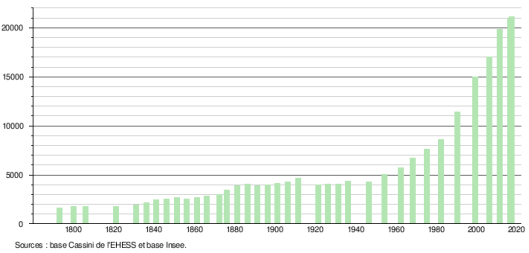
Sources : http://www.ville-gujanmestras.fr/la-ville-en-details
II.Natural Geography (environment and resources)

Gujan-Mestras is a commune in the southwest of France, in the department of Gironde, in the Nouvelle-Aquitaine region.
Geography:
Gujan-Mestras is located south of the Arcachon basin, in the Pays de Buch. Considered the capital of Arcachon oyster farming, Gujan-Mestras is home to seven ports facing the basin which run from west to east:
1)the port of La Hume which combines oyster farming and yachting,
2)the port of Meyran,
3)the port of Gujan,
4)the port of Larros with its promenade jetty and active center of naval constructions (Couach),
5)the port of the Canal,
6)the port of La Barbotière, oyster farming center, which also hosts the seafaring school and the shellfish house
7)the port of La Mole which has never been dredged or used because it is difficult to access.
Bordering municipalities: The neighboring municipalities are Le Teich to the east, La Teste-de-Buch to the west and Sanguinet to the extreme south.
Transportation:
Gujan-Mestras is served by the TER Nouvelle-Aquitaine connecting Arcachon to Bordeaux thanks to the two stations of the Lamothe - Arcachon line located in the town: those of La Hume and Gujan-Mestras.
The city is also served by the Baïa bus network, which connects the Dune of Pilat to Facture-Biganos, managed by COBAS. Lines 4 to 7 cross the town.
III.ECONOMY
Employment rate (%): 73.9 (2017)
Poverty rate by age group of the tax advisor(%): 9 (2017)
Average employment income (€):2 467 net per month (29 601 net per year)(2014)
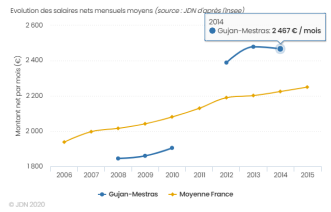
Evolution of average monthly net wages
Sources : http://www.journaldunet.com/business/salaire/gujan-mestras/ville-33199
https://www.insee.fr/fr/statistiques/2011101?geo=COM-33199
IV.Industrial Characterisitics
Oyster farming and shipbuilding (Couach, Dubourdieu ...) are the main activities of the 7 ports of the town.
Oyster farming:
Known as the oyster capital of the Arcachon Basin, Gujan-Mestras is a dynamic city that has always known how to take advantage of its natural resources.
Shipbuilding: Couach
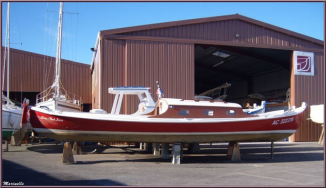
Shipyard Debord and Charmet, Port of Meyran in Gujan-Mestras, Arcachon Basin (33)
The Chantier Naval Couach, commonly known as Couach, is a century-old French company building yachts and service boats located in Gujan-Mestras, on the Arcachon Bay (Nouvelle-Aquitaine region and Gironde department). This company is made up of two departments: Couach Professional and Couach Yachts.
The Chantier Naval Debord & Charmet is a company which, in addition to providing repair and maintenance as well as guarding, produces boats like no other...
Grégory Debord is a shipwright, native of the country, who respects the tradition of the Arcachon Basin shipbuilding while respecting the environment...
After studying shipbuilding at the Lycée de la Mer in Gujan-Mestras on the Arcachon Basin, he acquired over many years the know-how in the construction of all types of boats (sailboats, pleasure boats, maritime and river passenger boats).
He works on various modern achievements in polyester, aluminum, traditional wood and mixed wood / polyester.
In 2006, he created his own company: the Debord shipyard.
Building on the company's growing success, it invested in the construction of a brand new production site.
A friendship, a philosophy, a shared know-how ... In 2012, the Debord shipyard became the Debord & Charmet shipyard.
After four years of successful production, the shipyard has produced 22 boats of different types and hulls: planing hull, sailboat, displacement hull.
Today the shipyard specializes in tailor-made and in the production of passenger boats with more than 60 seats with hybrid or 100% electric propulsion. In 3 years, the shipyard is proud to have built 6 boats, including 3 over 15 meters.
This shipyard, specialized and exclusive manufacturer of traditional pinnacles (oyster farming, yachtingce specializing in polyester barges. He also manufactures the traditional mixe, wheelhouse, petroleum, sailing tanker), is also the only shipyard in Frand dinghy (sail and motor) and speedboat of the Arcachon Basin.
COUACH, a public limited company with a management board, has been active for 50 years.
Based in GUJAN-MESTRAS (33470), it is specialized in the activity sector of the construction of pleasure boats.
In 2008 it achieved a turnover of € 54,000,000.00.
The balance sheet total increased by 27.05% between 2007 and 2008.
Societe.com lists 4 establishments and the last notable event of this company dates from 21-02-2012.
Nicolas FLEURIOT, is chairman of the supervisory board of the company COUACH.
Sources: https://www.societe.com/societe/couach-469202485.html
https://www.marinellebaladesphotos.fr/gujan-mestras-visite-d-un-chantier-naval-traditionnel-chantier-debord-charmet-bassin-d-arcachon-33/
V.Attractions
1.The Chêneraie park
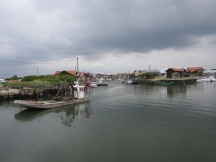
The Chêneraie park where you can discover the Landes canal. This artificial route is a vestige of Vauban who should have made it possible to link the Arcachon basin to Bayonne through the Landes ponds. Thanks to this monumental achievement, daring investors tried various crops including rice. For lack of manpower and water, this project was never completed.
2.Mills
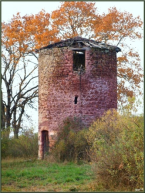
At the end of the 18th century, at the height of country industry, there were eleven mills in the town: seven windmills and four water mills.
Until the end of the 19th century, the inhabitants cultivated wheat, rye and millet. Thus, since the 18th century, water and windmills have punctuated the Pays de Buch. Currently we can say that the remains of the mills inventoried at that time can be counted on the fingers of the hand.
The mill of Larros: was erected by Mr. Darnaire, mason in Gujan, in 1808. We can read above the door, engraved in the stone, the inscription "Made by moy 1808 Darnaire". It was built for Vincent Dumeur. This windmill, built of "garluche" (ferruginous sandstone or alios stone), has no roof and wings, but the tower still exists today.
The Cantarane mill: is located at the border between Mestras and Le Teich just on the left at the start of the coastal path.
The most interesting and best preserved is certainly the so-called "chaouchoun" windmill of the "Frère Jean" built in 1815. It is located in a private property, at the corner of the Cours de la République and the rue Paul Pouget .
3. The Port of Larros
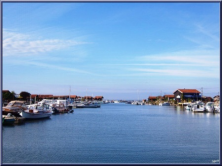
In 1883 and 1884, a 110 m long dock was dug and a median built. The interior embankment is extended by a jetty, terminated at its end by the Croix des Marins, erected in 1891. Between the two wars, Larros was an important fishing port which armed boats for sardine fishing, abundant in the Gulf. of Gascony. Several canneries then set up in the vicinity of the ports of Gujan. The sardines, migrating to Spain and Morocco, the factories are gradually closing. The port of Larros is also a recognized shipbuilding site. (shipbuilding: Fourton, Dubourdieu, Pradère, Lapeyre ...) all kinds of boats will come out of these sites: oyster pinnacles, sardine beds, pinassottes ... Today, the Couach shipyard is the leading French manufacturer of yachts. This 21st century high technology still rubs shoulders with the Dubourdieu shipyard in the port, a virtuoso of traditional construction which gives life to pinnacles and other traditional boats. With the Maison de l'Huître, its oyster huts, some of which serve as tastings, the port of Larros is a very popular tourist site.
Sources : https://www.marinellebaladesphotos.fr/gujan-mestras-capitale-de-l-ostr%C3%A9iculture-bassin-d-arcachon-33/
VI.History
OUR REGION UNDER ENGLISH DOMINATION
Since the marriage of Aliénor, heiress of Aquitaine "with Henri II Plantagenet, king of England, all Aquitaine is subservient to the English crown. This is how at the end of the fourteenth century the English hold well in hand this enormous territory which will not be recaptured until the end of the Hundred Years War and after the victory of Charles VII, king of France, in Castillon in 1451, who will then deliver Bordeaux and Guyenne. The Duchy of Aquitaine will be definitively attached to the French royal domain in 1472.
THE BIRTH OF THE CAPTALATE OF BUCH
After the death of his father Charles VII, the King of France Louis XI had returned to the captives of Buch their property, confiscated after the Battle of Castillon because of their attachment and loyalty to the crown of England.
Back from exile, Jean de Foix Candale in 1468 found his seigneury of Buch for the most part depopulated and grants a first “bail” in favor of Gujan, La Teste and Cazaux which provided benefits to the inhabitants of the three parishes that made up the "Captalate of Buch". Rights inhabitants were subsequently confirmed in numerous transactions with the lord of the captal of Buch and in particular in 1535, 1550, 1604 and 1645. These rights on "the mountain ”which still exist, although difficult to apply, have continued to give rise to serious protests, mainly in 1793, when a petition from the mass of the inhabitants of Captalat claimed property rights over the entire forest. These advantages obtained from 1468 and formulated for the first time by Jean de Foix Candale can nowadays be summed up to this: all inhabitants residing for five years in the municipalities of Gujan and La Teste (Cazaux is part of La Teste) may ask elected trustees to obtain the pine wood necessary for its heating and its constructions (house and boat). He can also collect dead, burnt or damaged wood no longer able to give resin. Finally, any inhabitant has the right to glandage, grazing and grazing.
THE PARISH OF GUJAN IN THE XVIIIth CENTURY
In 1726 the parish of Gujan had about 1500 inhabitants. The cultivated part is relatively little important because the inhabitants prefer to withdraw their subsistence from the sea rather than from the land; the fishing provides fine fish, and oysters and shellfish are always plentiful. Most a large part of the parish is made up of moors which extend to Cazaux. These moors are also very useful at this time and do not constitute lost ground; they are used for graze cattle and mainly ewes which are very happy on these lands, as well as on the salt meadows, and find healthier food there than anywhere else. Gujan's part cultivated is made up of plowed land (wheat, rye, buckwheat, corn ...) and vine located in edge of the basin.
This period, prosperous it seems, will only be slowed down by the Revolution, which our region, although isolated, will still suffer serious consequences. Thus in 1789 the Captalate of Buch was very weakened and, from Year II of the Republic, its last lord, François Amanieu de Ruat, renounced all its feudal rights, leaving the inhabitants to grapple with the right of use. The new administration then retains the boundaries of the old parishes but removes Cazaux which will be attached to La Teste.
AFTER THE REVOLUTION
THE DIFFICULT START OF THE NEW MUNICIPALITY OF GUJAN
After the Revolution, the revolutionary administration, which has just officially created the municipalities, leaves Gujan with enormous difficulties. In these troubled years which followed the Revolution of 1789, we must face the abuses of conscription that draws on the Gujanese youth a large contingent of sailors leaving to serve in the armies of Napoleon 1st. At the same time The terrible frost of Year X occurs, which destroys almost all of the country's vineyards. Deprived of income substantial, beset by the serious consequences of the Nezer, "La Montagne" and "property communal ”, to the difficulties of communications in the commune due to local roads too narrow (two carts not being able to cross) and with Bordeaux (the path leading there is impracticable six months because of the floods of the Leyre), the mayors, concerned with administration and realism face gigantic problems, but still succeed in giving our common a welcoming aspect. In "the guide for foreigners on the La Teste railway" in 1841, the author tells us: “In Mestras, the railway passes near low houses which give a laughing and full appearance life, all travelers are pleasantly surprised. At
moment of the high seas, the Basin, from which the waves come beat the edges of the railway levee, presents a magnificent spectacle. We see at certain times a multitude of boats sailing at full sail. Cultures main ones are grapevine, wheat, rye, millet, corn and potatoes, cultivated below and beyond some pine woods. The vine gives a fairly good income. The wine is commonly sold 45 to 50 F (the barrel Bordeaux). "
A small business then develops: when the path "Lou camin de Bourdéou" is practicable with carts and horses, the fishermen of Gujan thu bring the bulk of their catch (fish and oysters) in Bordeaux by taking a difficult and very sandy path which still exists (witness the “fishmongers” path between Mestras and Le Teich).
Known as the oyster capital of the Arcachon Basin, Gujan-Mestras is a dynamic city that has always known how to take advantage of its natural resources.
The first traces of the parish of Gujan-Mestras date back to 1274. It was then under the patronage of Saint-Exupère de Gujan, named after a bishop of Toulouse in the 5th century. Later, in 1572, the Jesuits took charge of it and decided to place it under the protection of Saint-Maurice.
During the Ancien Régime, Gujan-Mestras was subject to the authority of Captal de Buch who reigned over the region. She was then in the shadow of the neighboring parish of La Teste-de-Buch, whose forests she exploited. The inhabitants of the time made a living mainly from fishing, but also from the cultivation of millet and vines. They also keep sheep and bees in the moor.
It was only after the French Revolution that the town emancipated itself and began to develop. From 1823, resin distilleries proliferated. The creation of the Cazaux / La Hume canal in 1834, and the arrival of the railway in 1841, encouraged the growth of Gujan-Mestras. The local specialty then became oyster farming which appeared in 1857.
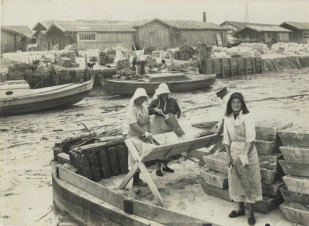
Oyster park
Sources: http://www.ville-gujanmestras.fr/histoire-et-patrimoine
VII.Other information
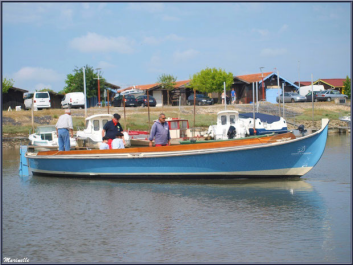
traditional sardine fishing in the Arcachon Bay
As every year, the association of "Barbots de Tous Temps" brings Gujan's heritage back to life for a day by organizing the "Great Festival of the Return of Sardine Fishing".
One can thus attend, at the Port of Larros, the departure and arrival of boats, the unloading of fish and nets, nets which are then spread on the fences.
The event then ends with a meal where the famous "Chanson du Bassin" is sung by all members of the association accompanied by the guests ... and many other old songs come to brighten up the meal.
The traditional menu is as follows: aperitif, oysters and sausages, sardines and steamed potatoes, cheese and dessert, coffee ... all washed down with an assortment of white, rosé and red wines.
A very convivial moment which takes place at the Port of Larros in Gujan-Mestras, on the "Pointon" esplanade.
This year the party took place on Sunday June 22. A magnificent sun and a gentle summer heat accompanied by the good iodized breeze from the Basin were there, thus allowing a perfect success of this day.
Local Urban Plan (PLU)
The Local Urban Plan (P.L.U.) is the main town planning document of the City. It succeeded the Land Occupation Plan (P.O.S) since the Urban Solidarity and Renewal Act (SRU) of December 13, 2000.
MODIFICATION N ° 6 OF THE LOCAL URBAN PLANNING PLAN:
In order to ensure the compatibility with the SAGE of the Born and Buch Littoral Ponds, aimed at integrating the mapping of the city's wetlands and inventoried in the SAGE, and to refer to it in article 7 of the regulation relating to the rules location of constructions.
Said deliberation is displayed in town hall for one month from Tuesday, July 2, 2019.
Cultural season
Supported by its institutional partners (IDDAC, General Council), the cultural service promotes education and awareness-raising actions in all artistic disciplines: theater, concert, dance, exhibition and cinema follow one another according to the seasons.
Cultural service
Mozart alley
33470 Gujan-Mestras
Phone. 05 57 52 59 31
Contact form
MAJOR EVENTS OF THE SEASON
Watch the cultural season from September to December 2020 online
They punctuate a rich and varied cultural program:
Childhood and Youth Day, City Carnival, Original Version Festival, 7 Ports Walk, Head in the Images Festival, Larros Thursdays, Open-air Opera, Heritage Days, Literary Festival of the "Thrillers Basin in Gujan-Mestras ", Christmas Village.
Sources: http://www.ville-gujanmestras.fr/plan-local-durbanisme-plu
https://www.marinellebaladesphotos.fr/gujan-mestras-f%C3%AAte-du-retour-de-la-p%C3%AAche-%C3%A0-la-sardine-et-histoire-de-la-p%C3%AAche-%C3%A0-la-sardine-bassin-d-arcachon-33/
http://www.ville-gujanmestras.fr/saison-culturelle
VIII.Contact information
Gujan-Mestras town hall address :
General de Gaulle Square
33470 Gujan-Mestras
Mayor : Marie-Hélène DES ESGAULX
Mail: bal.mairie@ville-gujanmestras.fr
Phone number: 00 33 (0)5 57 52 57 52
Fax: 00 33 (0)5 57 52 57 53
Website : http://www.ville-gujanmestras.fr
Sources : http://www.ville-gujanmestras.fr/la-ville-en-details
http://www.cartesfrance.fr/carte-france-ville/33199_Gujan-Mestras.html#mairie
